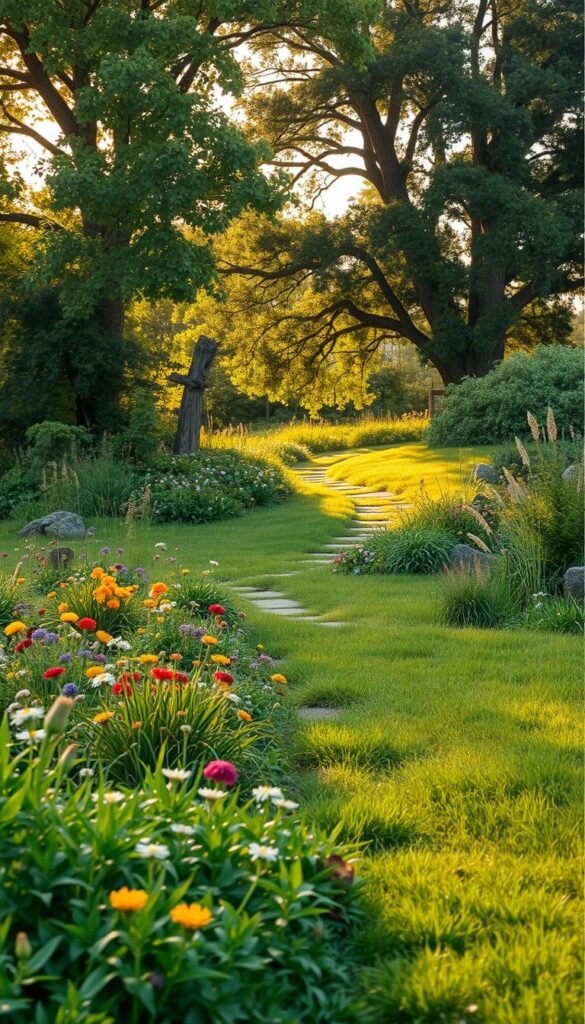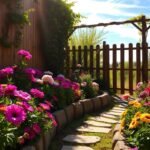Did you know over 31 million acres of turf grass blanket the U.S.—more than our cornfields? Many homeowners now swap their pristine lawns for vibrant, eco-friendly landscapes. Why? Traditional yards demand constant upkeep but offer little for local wildlife. Transforming your outdoor space into a thriving habitat isn’t just trendy—it’s a game-changer for ecosystems.
This shift reflects a growing awareness of ecological balance. Unlike uniform grass, diverse native plants attract pollinators, reduce water use, and cut maintenance. Imagine swapping weekend mowing for watching butterflies flutter through your wildflowers!
Redesigning your yard starts with simple steps. First, assess your soil and climate. Then, choose plants that thrive naturally in your region. The process isn’t about perfection—it’s about creating a living, breathing space that evolves with seasons. You’ll save time, support biodiversity, and craft a unique outdoor sanctuary.
Ready to join the movement? Whether you convert a small patch or your entire yard, every effort counts. Let’s turn resource-heavy lawns into flourishing habitats—one plant at a time.
Understanding the Lawn Transformation Journey
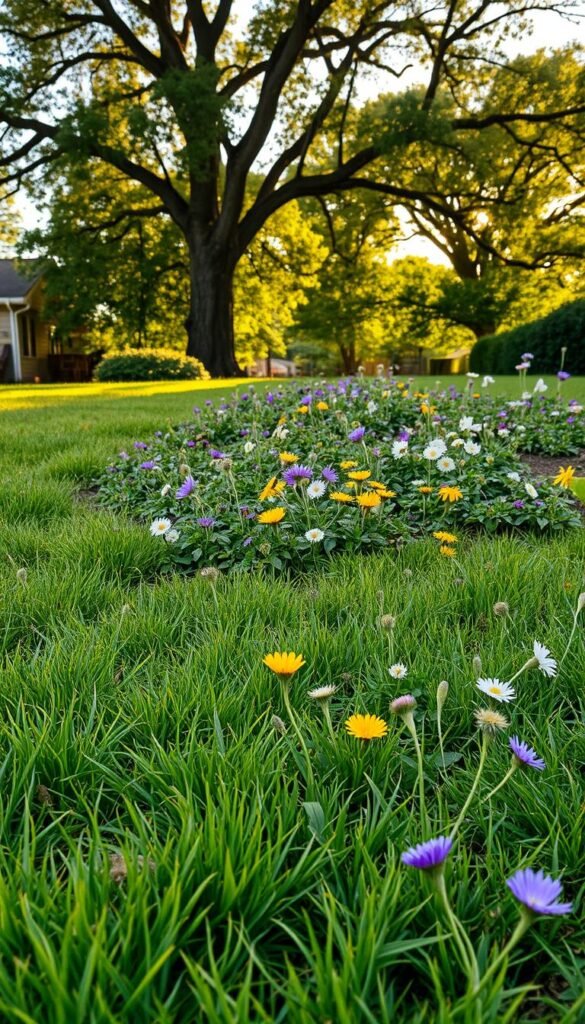
Every successful garden begins with thoughtful planning and realistic goals. Start by asking: Do you want buzzing pollinators, seasonal blooms, or a low-maintenance retreat? Your vision shapes whether you’ll cultivate a sunny meadow, a shaded woodland, or a mix of both ecosystems.
This planning phase impacts everything. Meadow-style gardens thrive with native grasses and wildflowers, while forest-inspired spaces need shade-tolerant plants. Your choice determines which species you’ll grow and how much time you’ll spend maintaining them.
Next, consider your yard’s unique conditions. Soil type, sunlight patterns, and drainage influence what grows best. A clay-heavy landscape might support different plants than sandy soil. Matching species to your environment reduces work and boosts survival rates.
Patience is key. Established gardens take 1-3 years to mature as roots deepen and wildlife discovers new habitats. You’ll trade weekly mowing for occasional pruning—a fair swap for butterflies dancing through your blossoming oasis.
The History and Ecological Value of Lawns
What began as a status symbol centuries ago now shapes modern American yards. In 16th-century England, wealthy landowners first cultivated lawns to showcase their wealth—fertile land used for beauty, not food. This trend crossed the Atlantic when figures like Thomas Jefferson redesigned their estates with sprawling greenswards, rejecting rigid garden styles for “natural” open spaces.
The 1870 push mower changed everything. Suddenly, middle-class people could maintain neat grass without hired labor. By the 1950s, suburbia turned lawns into a cultural must-have—a green carpet signaling prosperity. But this legacy hides an ecological cost.
Turf grass thrives under specific conditions: full sun, heavy watering, and chemical supplements. While durable for picnics or play, it creates ecological dead zones. Unlike native plants, it:
- Offers no food for pollinators
- Fails to absorb stormwater, worsening erosion
- Depletes soil health over years
“A great estate should resemble a fine carpet,” Jefferson once wrote. Today, we’re learning that carpets smother life beneath them.
Modern landscape design challenges this tradition. By rethinking your yard, you’re not just changing lawns—you’re reviving ecosystems. Every square foot converted helps rainwater soak in, feeds wildlife, and builds richer soil. It’s a shift from showcasing control to nurturing balance.
Defining Your Garden Vision and Setting Goals
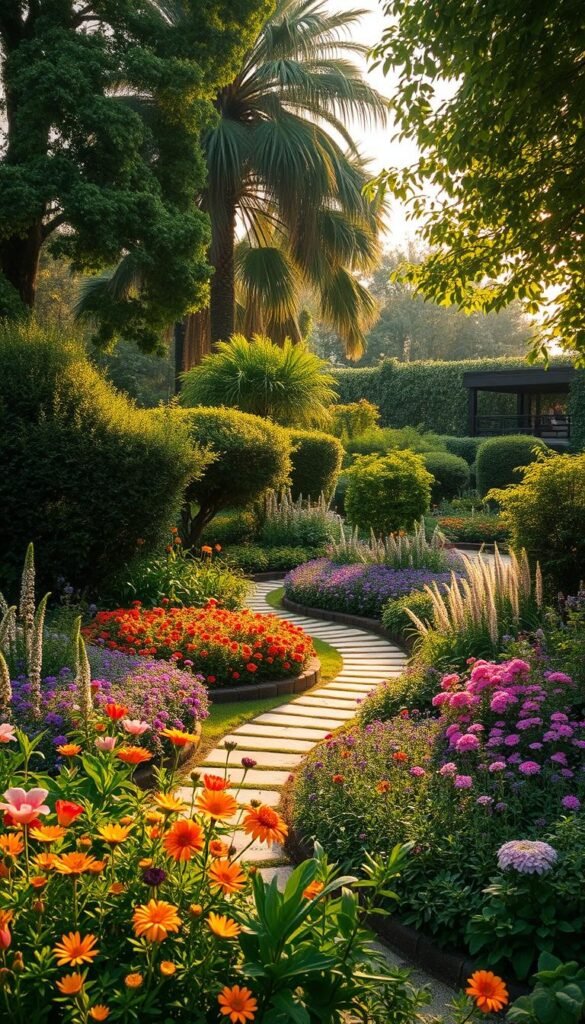
Your backyard holds untapped potential to become a thriving ecosystem. Start by asking: What role do you want your space to play? A sanctuary for wildlife, a colorful pollinator hub, or a low-effort native retreat? Your answer shapes every decision ahead.
Choosing the Right Habitat for Your Space
Meadows and woodlands support different plants and creatures. Sunny spots with well-drained soil become butterfly havens with milkweed and coneflowers. Shady areas under trees thrive with ferns and woodland phlox, sheltering birds and amphibians.
| Habitat Type | Sunlight Needs | Soil Preferences | Key Wildlife |
|---|---|---|---|
| Meadow | 6+ hours daily | Well-drained | Bees, butterflies |
| Woodland | 2-4 hours daily | Moist, rich | Songbirds, frogs |
| Transition Zone | Mixed light | Adaptable | Dragonflies, beetles |
Assessing Site Conditions and Soil Quality
Watch how water moves after rain. Puddles indicate poor drainage—ideal for swamp milkweed. Use a jar test to check soil quality: Sandy soil settles quickly, clay stays cloudy. Match native plants to these conditions for easier growth.
Track sunlight patterns monthly. South-facing areas get intense summer heat, while north sides stay cooler. This design groundwork ensures your garden works with nature, not against it.
Methods for Removing Your Lawn: Techniques and Tips
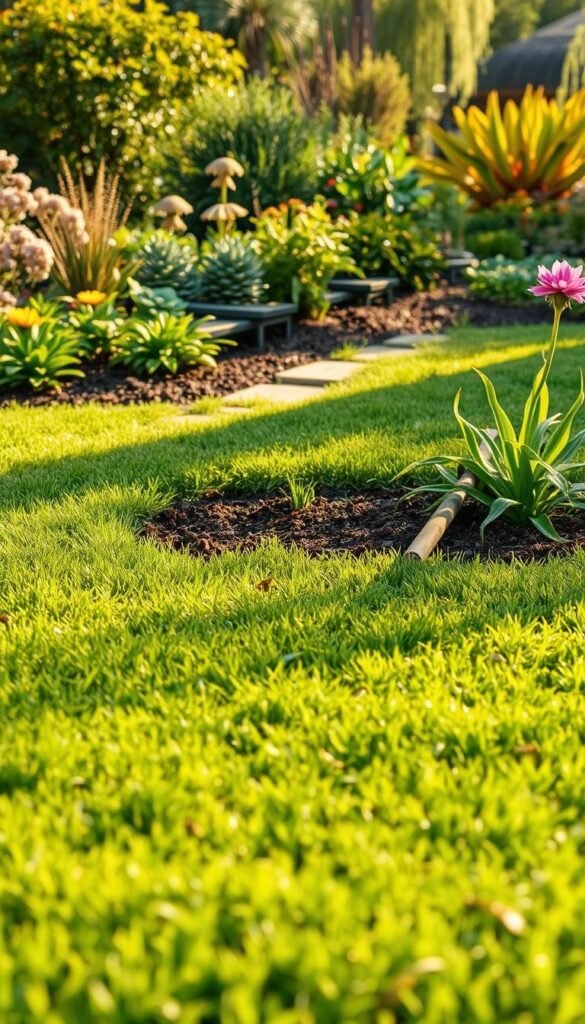
Removing turf grass might seem daunting, but modern techniques simplify the process while protecting your soil. Whether you prioritize speed or sustainability, there’s a method matching your needs.
Exploring Sheet Mulching and Manual Removal
Laura Tipton transformed her yard using recycled materials: “The cardboard method smothers grass naturally. Just remove tape, overlap sheets, and add mulch.” This way costs little and enriches soil as layers decompose. While waiting 2-3 months tests patience, it avoids harsh tools.
For immediate results, grab a shovel. Manual digging works best for small patches. You’ll preserve soil structure but need stamina. Remember: roots hide deeper than you think!
Comparing Sod Cutter and Tilling Alternatives
Rent a sod cutter for large areas. This machine slices grass roots, leaving plant-ready earth. At $100/day, it’s quick but creates waste—you’ll need to haul away rolls of dead sod.
Benjamin Vogt warns against tilling: “Disturbed soil becomes a weed buffet.” Rototillers churn up dormant seeds, creating future headaches. Instead, smother grass with cardboard or remove it cleanly with tools.
| Method | Cost | Time | Effort |
|---|---|---|---|
| Sheet Mulching | $0-$50 | 2-6 months | Low |
| Manual Digging | $30 (tools) | 1 weekend | High |
| Sod Cutter | $100+/day | 1 day | Medium |
Choose your way based on budget and timeline. Want instant gratification? Rent equipment. Prefer eco-friendly ways? Let cardboard and mulch work while you relax.
From Lawn to Natural Garden: Easy Steps to Convert Grass into Growing Space
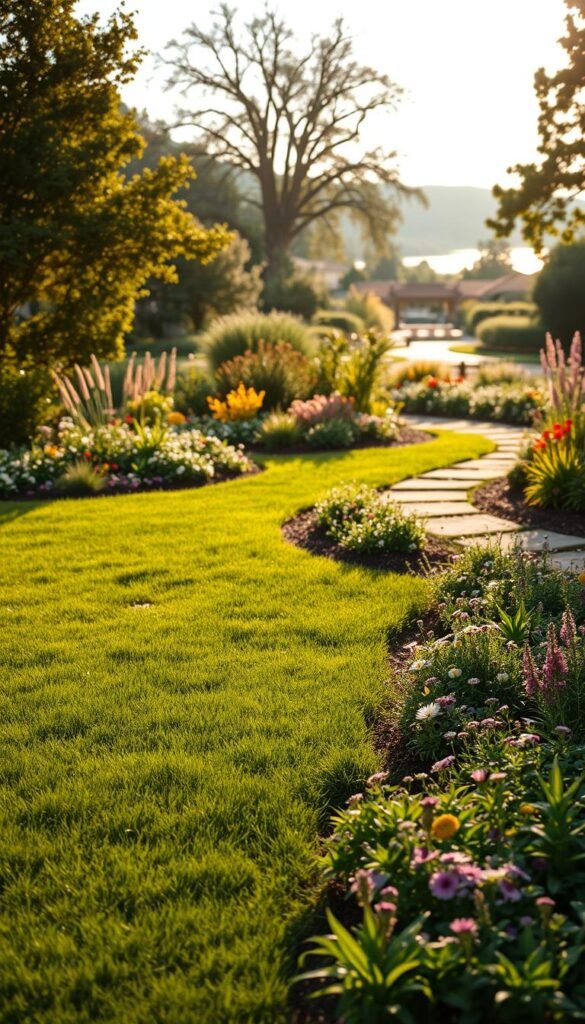
Timing becomes your greatest ally after clearing turf. Whether you’ve smothered grass with cardboard or sliced it away, planting swiftly prevents opportunistic weeds from claiming bare earth. Spring’s gentle rains and fall’s cooling soils create ideal conditions for roots to establish before extreme weather hits.
- Install seedlings or sow seeds within 48 hours of grass removal
- Cover unplanted areas with 3 inches of straw or wood-chip mulch
- Water deeply once, then let seasonal rainfall take over
Why the rush? Nature quickly fills empty spaces—often with plants you didn’t choose. As master gardener Linda Whitlock notes: “Bare soil is like an open invitation. Your desired plants need first dibs on sunlight and nutrients.”
This phase works beautifully for productive backyard spaces or wildlife havens. Cool-season planting in September allows perennials to develop robust root systems before summer heat. Spring starters get a growth boost from increasing daylight.
| Season | Advantage | Best For |
|---|---|---|
| Spring | Longer days accelerate growth | Annual flowers, veggies |
| Fall | Less watering needed | Native shrubs, perennials |
Mulch acts as both protector and nurturer. It keeps soil moist during dry spells while breaking down into organic matter. Within months, earthworms transform this layer into rich humus—creating a self-fertilizing system for your new garden.
Creating Garden Beds and Enhancing Soil Quality
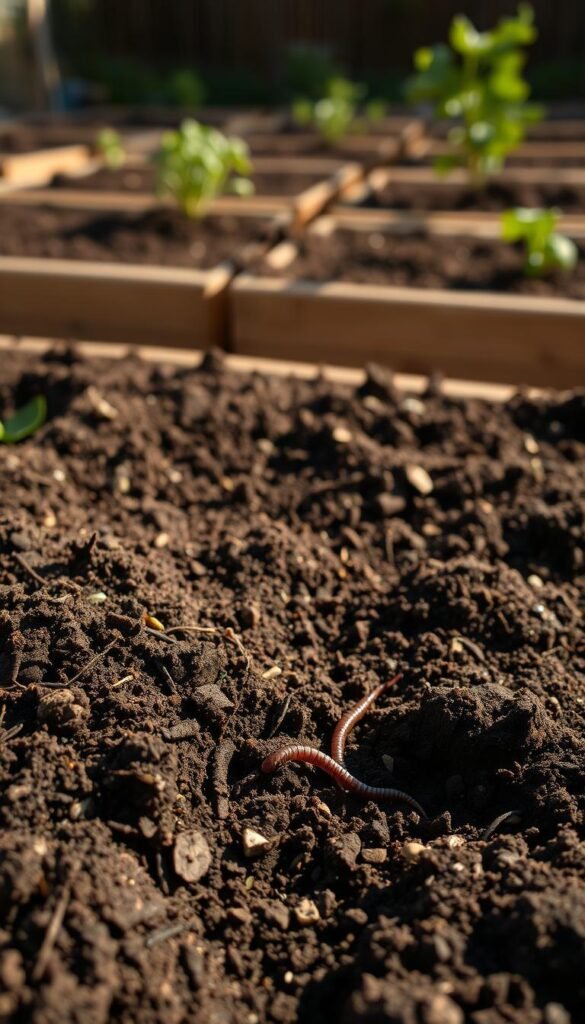
Transforming your yard continues with crafting spaces where plants thrive. Raised garden beds offer a practical solution—they elevate roots above poor drainage and let you customize soil conditions. This approach works wonders in urban yards or areas with compacted earth.
Building Raised Garden Beds for Optimal Growth
Start with 2×10 lumber—a budget-friendly choice providing 10-12 inches of depth. This height accommodates most vegetable roots while improving airflow. Assemble rectangular frames to fit your space, leaving 3-foot-wide paths for easy access.
Layering Soil, Compost, and Mulch Effectively
The magic happens in three steps:
- Cardboard base: Blocks weeds while decomposing into organic matter
- Soil-compost mix: 60% topsoil + 40% compost feeds roots
- 2-3 inches of mulch: Retains moisture and regulates temperature
| Layer | Depth | Function |
|---|---|---|
| Cardboard | 1/4 inch | Weed barrier |
| Soil mix | 8-10 inches | Root support |
| Mulch | 2-3 inches | Moisture control |
This system mirrors natural forest floors. As landscape designer Benjamin Vogt advises: “Let the soil work for you—healthy layers mean less maintenance.” For more tips, explore our guide on DIY garden bed prep.
Raised beds warm faster in spring, extending your growing season. They also reduce bending—a relief for your back! Just refresh the compost annually to keep nutrients flowing.
Adding Features: Fences, Irrigation, and Native Plants
Your outdoor space becomes truly yours when tailored to fit both needs and nature. Thoughtful additions like fences and irrigation systems elevate functionality while supporting your plants and local ecosystems. Let’s explore how these elements blend practicality with sustainability.
Installing Fences for Privacy and Protection
A well-placed fence does more than mark boundaries. It creates a cozy retreat where you can enjoy flowers or grow vegetable crops without prying eyes. Choose rot-resistant cedar planks for DIY builds—they last longer and blend naturally into your design. Avoid treated wood near edibles to keep chemicals out of your harvest.
Setting Up a Drip Irrigation System
Save time and water with targeted hydration. Drip systems deliver moisture directly to roots, cutting usage by 50% compared to sprinklers. Pair this with native plants adapted to your climate for even greater efficiency. You’ll spend less time dragging hoses and more days admiring blooms.
For soil health, consider organic garden practices like compost tea or straw mulch. These methods nourish plants naturally while keeping roots cool during summer heat. As your native plants mature, they’ll attract pollinators—turning your yard into a living tapestry of flowers and buzzing life.

